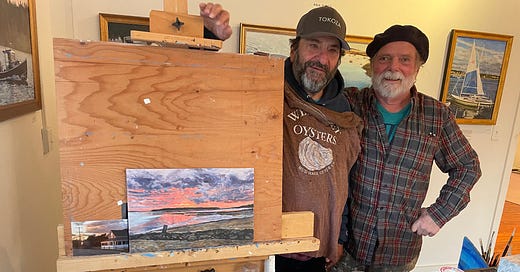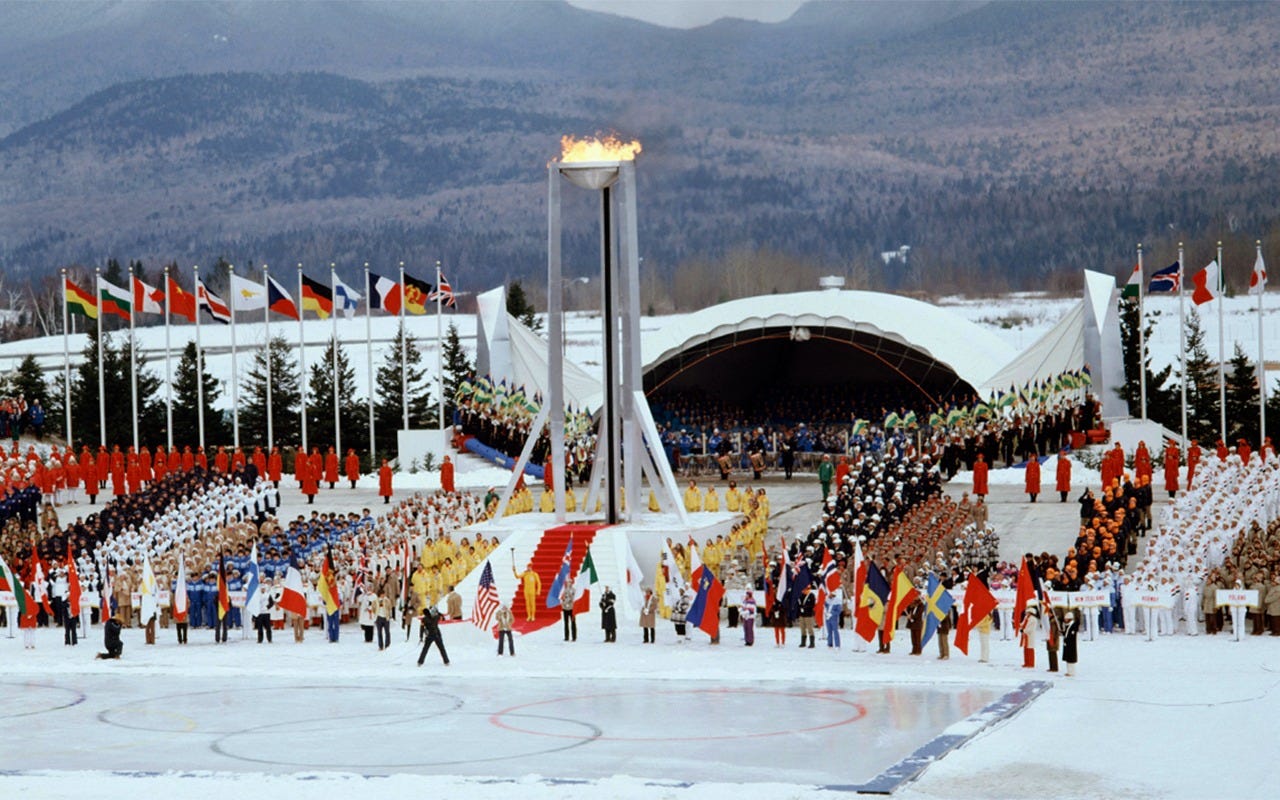Crashing the Olympics, Lake Placid, 1980
When out-there Cape Codders sold Wellfleet oysters to the world
Paul Suggs wearing a beret, with Gary Joseph modeling (kind of) the original Wellfleet Oysters t-shirt (now 42 years old), alongside several of Paul’s sunset paintings (roughly 42 days old), in Paul’s gallery “The Works” on Commercial Street, Wellfleet.
****
As the Winter Olympics wrap up, it’s a good time to set the wayback machine to 1980 and revisit a bunch of crazy-ass characters who decided -- no hard plans, no money -- to crash Lake Placid, New York and hawk Wellfleet oysters at the Winter Olympics 42 years ago.
This saga unfurls like a counter-culture fairy tale, set in a time of spontaneity and wacky initiatives, long before heavy-duty security, fears of terrorism, layers of permits, licensing, and insurance, dominated life.
While some of these memories may have embellished and romanticized over the years, rest assured this really happened. And rest assured it never would today, because it never could.
****
During a typical bleak Cape Cod February, Paul Suggs got it into his restless, creative head that he could make some money -- but even better have a great time -- at Lake Placid, where the sports world was converging. Suggs was Wellfleet’s Mud Hake Oyster Company, known for exploits of many kinds well beyond oystering, you might say. He started “buying every oyster in Wellfleet,” building a stash of about 80 bushel, storing them in his friend Randy Williams’ cooler. People wanted to know what the hell he was doing. He didn’t say much, yet.
When the time was right he revealed his plans, which included renting a U-Haul to pack up the oysters, clams as well, print t-shirts of his own design that became the iconic Wellfleet Oysters shirt, and encourage other “knuckleheads” (as he affectionately referred to a band of counter-culture characters) to join the escapade.
Gary Joseph stepped in, bringing his 10-year-old son Adam along. So did Ron Metzger with his boy Woody of the same age. Paul Coulombe, Craig Adams, more families and kids, the group kept growing.
Paul and Gary took off in the U-Haul.
“Seemed like it took us forever to get there,” Gary remembers, “and every mile we went it got colder.” There was no ice or refrigeration in the back of the truck, but the guys weren’t worried about the oysters getting warm and spoiling, “we were worried about them freezing.” The Metzgers headed north in Ron’s Dodge truck, and Woody’s job was to hold a piece of cardboard against the busted triangular vent window old cars sported, keep out the wind.
Paul had given them a destination called “the Olympic Mountain Inn,” across from White Face Mountain where the downhill events would take place. He figured it would be a great spot to sleep, set up a raw bar, and get to business. But when they settled in it became apparent that the inn was, well, “a little creepy,” and not a good business location. People from other locales were showing up to sell stuff too, but Lake Placid had set up a shuttle bus to ferry people to the Olympic sites and the buses were bypassing their digs. “La Bleak” became their nickname for the place.
Some guys from Staten Island had shown up to sell food and booze, one thing led to another, and Suggs got into a late-night pool hustle with one of them. By sunrise the guy owed Paul $700 he didn’t have, so offered as payment cases of minestrone soup they had carried up. In the days ahead the soup would help feed almost 20 Cape Codders who were caravanning in.
The crew vacated La Bleak in a few days, located a house to rent (no reservation or realtor of course, just sussed it out), then zeroed in on the only decent hotel in Lake Placid proper, the Ancient Mariner with foot traffic tromping by the hotel’s windows. Clearly this was where they should make their stand. The crew set up shop and began shucking, hucking platters of oysters on the street, inviting people in for more – and featuring their new attraction, “homemade minestrone soup.”
“There was no permit, no nothing,” Paul remembers. “We showed up and it was just, ‘Here’s your spot!’”
Customers started showing up too. One of their favorites was a guy they called “Mr. Big,” who would come with his family who became “the little Bigs.” He would down 50 or 60 oysters at a sitting. In the hotel, visitors from every continent were coursing by, stopping on their way to the dining room to talk if not slurp.
The actual Games hadn’t begun yet but practice at various venues was in full swing; you could take a free shuttle, even a toboggan, go from site to site, no tickets, few barricades, and watch the world’s greatest athletes up close. Paul remembers sitting on stairs below the towering ski jump, seeing Olympians trudge up, then watch as they soared far over his head.
For 10-year-old Woody (some readers might remember I wrote about Woody and his First Light Boatyard awhile back), the whole scene was “100 percent magic.” The kids were set free in the compact town (Lake Placid was a little larger than Orleans but smaller than Hyannis). One parent might be assigned to look after them – Gary would load them all onto a bus for a cruise to the venues -- but often they roamed, sneaking strudel or pizza depending on what country’s fare was nearby, hearing languages from all over the globe.
Even after the Games began it didn’t change much. Woody remembers the biggest star, skater Eric Heiden, who won five golds that year (the most ever for one winter athlete). Heiden, who later became a physician, recognized Woody from the oyster bar, called him over, took him by the hand, and escorted him to the edge of the ceremonial stage to see Heiden receive one of his medals. Every evening there would be a parade of athletes through the center of town that passed by the Ancient Mariner. The Codders would call it a day (until the disco party that night), and many an evening one of the kids was handed a flaming torch that led the parade to the lake.
Lake Placid, 1980
If there is one Lake Placid moment that lives on in sports history it’s the US ice hockey team defeating the Russians, then winning the gold. The Russians were professionals, part of the Red Army, invincible, plus the Soviet Union had just invaded Afghanistan and no one wanted to see them succeed. The US team was composed of college athletes; no US professionals were allowed in the Olympics at that time. It was a total mismatch.
Suggs had his oyster t-shirt on when he heard people calling to him from a table, “Hey Wellfleet!” It was some of the US hockey team getting ready to play the Russians the next day:
“I said, ‘Listen, here’s the deal. I’ll give you guys as much free oysters and clams as you want, on one condition: No one can have sex tonight! If you stick to that you’ll win. Otherwise you’ll blow it.’”
They promised, he delivered, so did they at what became known as “the Miracle on Ice.”
News outlets found the oyster crew; stories on national television, in the infamous Russian news outlet TASS, features appeared in papers all over the country.
“That was great because one of the reasons we were there was we wanted to promote Wellfleet oysters, put them on the map,” says Paul. “But what was really great was to be in that climate of people getting along together, hospitable, friendly, it just flowed. No one was afraid of somebody different. There was such camaraderie, everybody wanted to meet everyone else.”
Some stayed for a week or two. Paul stuck it out for a month before making his way back, where he remains a Wellfleet character and celebrated painter. Gary is a Wellfleet conservationist and stalwart as well. They came home with amazing memories, but pockets as empty as when they left.
The Olympics have become less personal and “amateur,” higher tech, almost robot-like. The Games don’t evoke the same spirit, their spontaneity, excitement, and humanity diminished. Here’s hoping that’s not a symbol of life in general, though this fairy tale does conjure that concern:
“It breaks my heart that things like this don’t seem possible anymore,” says Woody, who still lives in Orleans and now has a 12-year-old son with an international name; Oslo.
(With thanks to David Wright, who chronicled some of this story in his book, “The Famous Beds of Wellfleet, a shellfishing history,” available from the Wellfleet Historical Society, and Wellfleet Town Moderator Dan Silverman for the inspiration.)
NEXT: WHO IS SARAH OKTAY?
Haven’t subscribed yet? Here’s how to keep seeing a Voice:






Great story,Seth!
Seth, You most certainly captured that amazing period. The young American amateur hockey team's defeat of the Russians was one of those special events whereby folks remembered where they were when it happened !